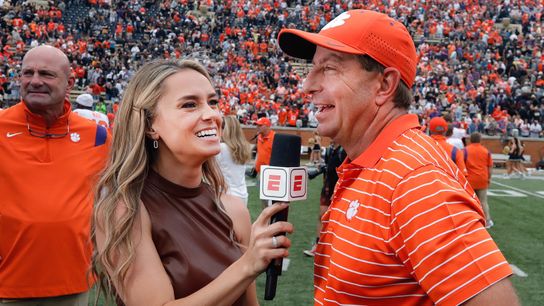Faced with the possibility of extinction, the ACC did the math. And it will require more math.
Following years of saber-rattling and lawsuit-filing by Florida State and Clemson, the Seminoles and Tigers dropped their lawsuits against the conference back in March. The ACC and its most high-profile schools plan to move forward together, and details of how the conference plans to move forward while remaining intact are starting to trickle out.
The Athletic reported Thursday that, moving forward, 40 percent of the ACC's TV money will be split equally among the 14 "legacy" schools (Cal and Stanford receive 30 percent payouts, and SMU receives nothing for seven years). The remaining 60 percent will be based on TV viewership; 75 percent of that 60 percent (45 percent of the money in total) will be based on football TV ratings, and 25 percent of the 60 percent (15 percent of the total) on basketball TV ratings.
Hard numbers of how the formula will be calculated and how much money is at stake is unclear at this time, though we are talking about significant money here. The Athletic reported Clemson believes this new formula will net an extra $120 million over the next six years. (The ACC distributed $45 million per school in 2023-24, though not all of that is TV money.)
Obviously, this is a self-fulfilling prophecy. The bigger the brand you are and the more successful team you have (not always the same thing, as you'll see below), the more likely you are to appear in priority TV windows. The more valuable TV real estate you occupy, the more money you make. The more money you make, the more likely you are to field a team worthy of being in prime TV windows. Round and round the circle goes.
For instance, Syracuse appeared on big-boy ESPN three times en route to its 10-3, AP top-20 season. Florida State, who went 2-10, got on ESPN five times. Miami was on ESPN five times, and on ABC four. Clemson was on ABC or ESPN 10 times, including the ACC Championship, plus a CFP game on TNT. The ACC appeared in 20 of the 100 most-watched games of the 2024 season, the first season that ABC/ESPN held exclusive rights to the SEC alongside the ACC. ABC time slots were in far shorter supply than they were previously with the SEC consistently occupying double- and triple-headers, so gobbling up as many as you can (along with the prime ESPN windows) will be massively important for each ACC school.
That $120 million in "new" money Clemson expects to make? That's $120 million that Syracuse and Wake Forest and Virginia won't be making.
So, why would Syracuse and Wake Forest and Virginia agree to the Balkanization of their own conference, with first- and second-class citizens and some of the most powerful people in the ACC are faceless programming executives in Bristol? Because they did the math. Florida State first signaled its intent to sue its way out of the ACC in December 2023. Would they have been successful in breaking the Grant of Rights contract they willfully signed years ago? No one knows. It had never been tried, and has still never been tried. But in that 15-month period between lawsuit and settlement, the rest of the ACC got to imagine what life would be like without Florida State, and Clemson (and possibly/likely Miami, North Carolina, and others). It couldn't have been pretty.
Bitter as it is, the reality that the remaining ACC schools accepted is that it's in their best interest to pay Clemson and Florida State like they're SEC and Big Ten members, so they don't try to join the SEC and Big Ten.
